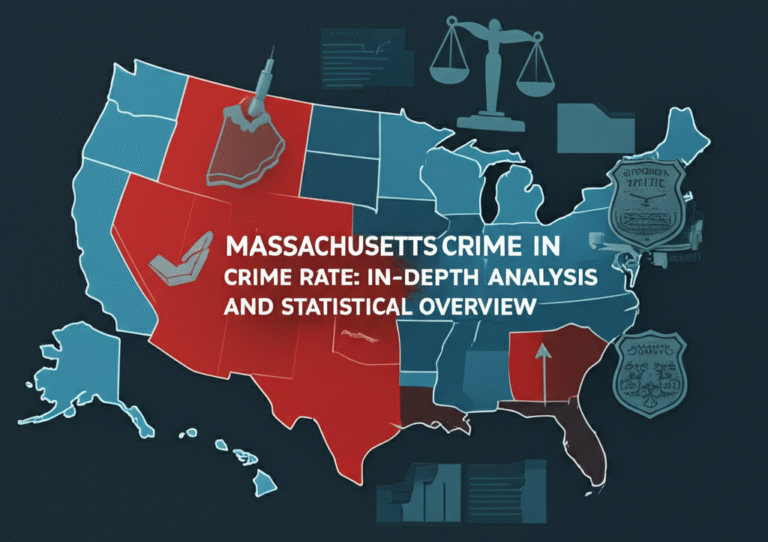Tennessee Crime Rate: Comprehensive Overview and Statistical Analysis
Have you ever wondered how safe Tennessee really is? The reality of crime within this vibrant state shapes the everyday lives of its residents. Understanding the complexities of the Tennessee crime landscape goes beyond just knowing numbers; it means exploring the roots of social challenges, the role of law enforcement, and how criminology and criminal justice work together to promote public safety and justice. Whether it’s through legal action or community efforts, grasping the significance of crime statistics is essential to addressing the social issues Tennessee faces today.
- Tennessee’s crime rate reflects varying challenges in violent and property crimes compared to national medians.
- Analyzing crime types and rates supports law enforcement strategy, public policy, and criminal justice efforts.
- Understanding crime data enhances awareness of social issues, legal action, and public safety in Tennessee.
You are invited to take a journey into the heart of Tennessee crime rate, uncovering the stories behind the numbers and how they influence the state’s approach to safety and order.

Overview of Overall Tennessee Crime Rate
The total volume of crime in Tennessee presents a detailed picture of public safety challenges across the state. In total, more than 213,000 cases were reported, producing a total crime rate of 29.90 incidents per 1,000 residents. This broad category covers both violent crime and property crime, which vary widely in frequency and impact. Of these, violent crimes account for 44,769 incidents, registering a rate of 6.28 per 1,000 residents, signaling concerning pockets of violence. Yet, it is property crime that dominates, with 168,314 cases at a rate of 23.62 per 1,000 residents, demonstrating widespread challenges around theft and property loss. Such crime statistics provide a foundation for efforts in policing and community protection focused on reducing these risks.
| Crime Category | Total Cases Reported | Rate per 1,000 Residents |
|---|---|---|
| Total Crimes Reported | 213,083 | 29.90 |
| Violent Crime | 44,769 | 6.28 |
| Property Crime | 168,314 | 23.62 |
Detailed Violent Crime Statistics in Tennessee

Drilling down into Tennessee’s violent crimes uncovers specific statistical realities crucial for understanding the state’s safety profile. The violent crime category includes murders, rapes, robberies, and assaults, each contributing uniquely to the overall picture. Murder rates reflect a slight increase above the national median, with 703 cases amounting to a rate of 0.10 per 1,000 residents.
Assault stands out sharply with 36,293 reported incidents, corresponding to a rate of 5.09, signaling significant challenges in physical violence. Cases of rape tally 2,678 with a rate matching the national standard at 0.38, while robberies are recorded at 5,095 incidents with a rate of 0.71. For residents, the risk translates to roughly a 1 in 159 chance of becoming a victim of violent crime, a sobering figure that underlines the importance of targeted legal action and prevention.
The thorough examination of these figures helps law enforcement and criminal justice specialists focus their resources effectively. To explore comprehensive data, visit the FBI Uniform Crime Reporting site.
| Violent Crime Type | Reported Total | Rate per 1,000 Residents |
|---|---|---|
| Murder | 703 | 0.10 |
| Rape | 2,678 | 0.38 |
| Robbery | 5,095 | 0.71 |
| Assault | 36,293 | 5.09 |
Violent Crime Comparison: Tennessee vs National Rates
When comparing Tennessee’s violent crime rates to national figures, some contrasts stand out clearly. The state’s overall violent crime rate of 6.28 per 1,000 exceeds the United States median rate of 4.0. Among these, the murder rate in Tennessee at 0.10 per 1,000 is slightly above the national average of 0.06, highlighting serious concerns. Assault crimes show even more dramatic differences, with Tennessee’s rates nearly doubling the national median at 5.09 compared to 2.64 per 1,000 residents.
Robbery and rape rates align closer but still mark Tennessee as a state facing above-average challenges in public safety. Such differences signal opportunities and needs for enhanced criminal justice measures and community engagement to bridge these gaps. These detailed crime statistics facilitate nuanced understanding crucial for policymakers and protection agencies. Further reliable data can be referenced on the FBI’s crime statistics portal.
| Crime Type | Tennessee Rate | National Median Rate |
|---|---|---|
| Violent Crime | 6.28 | 4.0 |
| Murder | 0.10 | 0.06 |
| Rape | 0.38 | 0.38 |
| Robbery | 0.71 | 0.67 |
| Assault | 5.09 | 2.64 |
Property Crime Insights and Statistics in Tennessee

The prevalence of property crime in Tennessee demands a close look, as it constitutes the majority of criminal incidents. These include burglary, theft, and motor vehicle theft, each representing unique challenges for residents and authorities alike.
Among these offenses, theft dominates with 115,002 reported cases and a high rate of 16.14 incidents per 1,000 residents. Burglary cases count at 21,145, with a rate just below 3 per 1,000. Motor vehicle theft also contributes significantly, with 32,167 cases and a rate of 4.51. Collectively, these figures surpass national medians, underscoring areas where security and criminal law enforcement can improve.
Focused efforts on prevention and awareness help strengthen public safety and reduce losses for Tennessee’s communities. Such detailed crime statistics serve as a roadmap for policymakers and law enforcement to draft effective crime deterrence strategies.
| Property Crime Type | Reported Total | Rate per 1,000 Residents |
|---|---|---|
| Burglary | 21,145 | 2.97 |
| Theft | 115,002 | 16.14 |
| Motor Vehicle Theft | 32,167 | 4.51 |
Comparing Property Crime Rates: Tennessee and United States
Placing Tennessee’s property crime data side-by-side with national statistics reveals a distinct pattern of elevated risks. The burglary rate of 2.97 per 1,000 residents exceeds the U.S. median of 2.51, indicating more frequent break-ins. Theft is particularly concerning, with a Tennessee rate of 16.14 well above the national rate of 13.47, suggesting widespread vulnerability.
Similarly, motor vehicle theft is more common in Tennessee at 4.51 cases per 1,000 residents compared to the national 3.19. Residents face an approximately 1 in 42 chance of being a victim of some form of property crime, emphasizing the need for vigilance and strategic crime prevention efforts. These comparisons highlight areas where community and law enforcement collaboration is vital for maintaining public safety and reducing risk. For more specific national insights, visit the Bureau of Justice Statistics.
| Property Crime Type | Tennessee Rate | National Median Rate |
|---|---|---|
| Burglary | 2.97 | 2.51 |
| Theft | 16.14 | 13.47 |
| Motor Vehicle Theft | 4.51 | 3.19 |
Crime Density: Crimes per Square Mile in Tennessee

Measuring crime density offers important insights into how crime is distributed across Tennessee. With 16 crimes per square mile, Tennessee experiences a moderate level of crime density, which is below the national median of 26.5. This lower density does not necessarily mean fewer crimes overall but indicates that crimes may be more dispersed geographically.
Urbanization, population clusters, and social environments heavily influence this spatial distribution. A deeper understanding of crime rate per area equips law enforcement agencies with the information needed to optimize resource deployment and tailor crime prevention techniques according to locality. Such analysis is pivotal in criminology for developing targeted strategies to improve public safety while respecting community needs.
| Location | Crimes per Square Mile |
|---|---|
| Tennessee | 16 |
| National Median | 26.5 |
Top Safest Cities in Tennessee
Among the diverse communities in Tennessee, certain cities stand out for remarkable safety and low crime levels. Leading this list is Lavinia, which holds the title of the safest city, followed by Hilham and Cottage Grove. The remainder of the top ten includes Holladay, Normandy, Fort Campbell, Dellrose, Dukedom, Enville, and Leoma. These cities demonstrate how effective crime prevention and robust community engagement contribute to safer environments. Their commitment to public safety fosters strong social institutions that support stability and trust in local law enforcement. The accomplishments of these places highlight how collaboration, vigilant practices, and proactive policies collectively reduce crime and enhance quality of life.
| Rank | City |
|---|---|
| 1 | Lavinia |
| 2 | Hilham |
| 3 | Cottage Grove |
| 4 | Holladay |
| 5 | Normandy |
| 6 | Fort Campbell |
| 7 | Dellrose |
| 8 | Dukedom |
| 9 | Enville |
| 10 | Leoma |
Popular Cities in Tennessee and Crime Data Overview

The urban landscape in Tennessee is characterized by cities like Nashville, Memphis, and Knoxville, which are among the most prominent in population and economic activity. Their sizeable and diverse populations contribute to varied crime profiles, requiring law enforcement agencies and policymakers to adapt approaches to public safety carefully. These metropolitan areas face distinctive challenges due to higher population density and the diversity of crime types compared to smaller towns.
Although detailed crime data for several popular cities such as Bartlett, Chattanooga, and Clarksville is not publicly provided, understanding their dynamics remains essential. Tailored crime mitigation and community-oriented policing initiatives thrive when backed by the knowledge of each city’s unique social fabric. This complexity positions Tennessee’s urban centers as critical focuses for ongoing social research and planning by demographics organizations.
| City | Crime Data Availability |
|---|---|
| Bartlett | [city_crime_row city=”Bartlett” state=”Tennessee”] |
| Chattanooga | [city_crime_row city=”Chattanooga” state=”Tennessee”] |
| Clarksville | [city_crime_row city=”Clarksville” state=”Tennessee”] |
| Collierville | [city_crime_row city=”Collierville” state=”Tennessee”] |
| Franklin | [city_crime_row city=”Franklin” state=”Tennessee”] |
| Hendersonville | [city_crime_row city=”Hendersonville” state=”Tennessee”] |
| Jackson | [city_crime_row city=”Jackson” state=”Tennessee”] |
| Johnson City | [city_crime_row city=”Johnson City” state=”Tennessee”] |
| Kingsport | [city_crime_row city=”Kingsport” state=”Tennessee”] |
| Knoxville | [city_crime_row city=”Knoxville” state=”Tennessee”] |
| Memphis | [city_crime_row city=”Memphis” state=”Tennessee”] |
| Murfreesboro | [city_crime_row city=”Murfreesboro” state=”Tennessee”] |
| Nashville | [city_crime_row city=”Nashville” state=”Tennessee”] |
| Smyrna | [city_crime_row city=”Smyrna” state=”Tennessee”] |
| Spring Hill | [city_crime_row city=”Spring Hill” state=”Tennessee”] |
Data Collection and Crime Analysis Methodology in Tennessee

The foundation of Tennessee’s crime analysis lies in robust crime data collection and rigorous data methodology. Information is sourced primarily from about 18,000 local law enforcement agencies across the United States, creating one of the most extensive crime data series available. To maintain reliability, the data undergoes annual updates, coupled with meticulous error correction to ensure comprehensive and accurate entries. This process entails a meta-analysis involving millions of individual crime reports, complete with precise geolocation to contextualize incidents spatially.
By integrating these official statistics within well-defined statistical data sets, criminologists and policymakers gain a powerful tool for understanding and responding to crime trends effectively. Institutions like the Bureau of Justice Statistics oversee and support this methodology, making Tennessee’s crime data both representative and actionable. For more information about these practices, visit the Bureau of Justice Statistics website.
Conclusion
In wrapping up our comprehensive overview of the Tennessee USA crime rate, it’s clear that crime statistics play a pivotal role in understanding the broader social issues and public safety challenges within the state. The analysis of violent crime and property crime rates, compared against national averages, underscores the need for effective law enforcement techniques and criminal justice reforms.
Tennessee’s crime data, reflecting both the hazards and the societal responses to deviance and misconduct, offers a foundation for addressing the root causes of injury and violence. The interplay between social ethics, legal action, and public law highlights the importance of a multidisciplinary approach to criminology and emergency management. As we consider the future of public safety in Tennessee, the insights gleaned from this statistical analysis can guide policymakers, law enforcement, and community leaders in fostering a safer, more just society. The commitment to reducing crime and enhancing national security, while upholding human rights and equality, remains a collective responsibility that requires ongoing attention and action.




